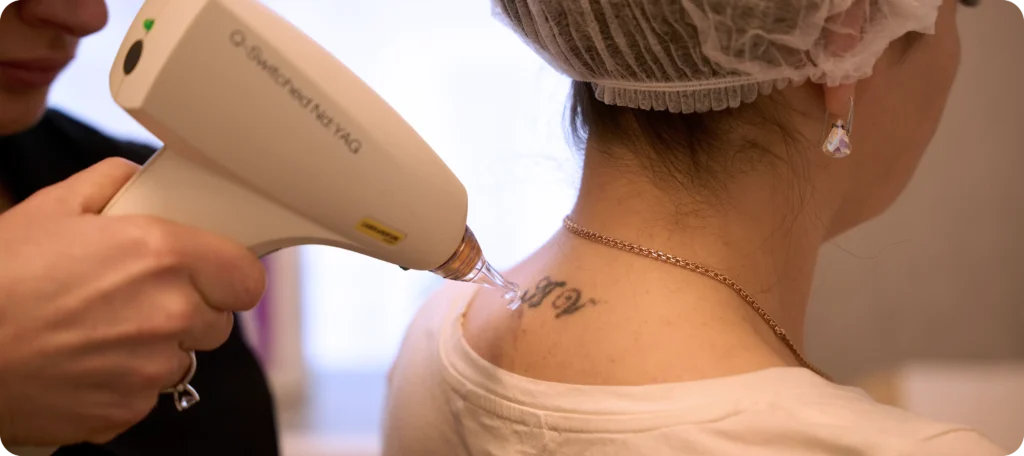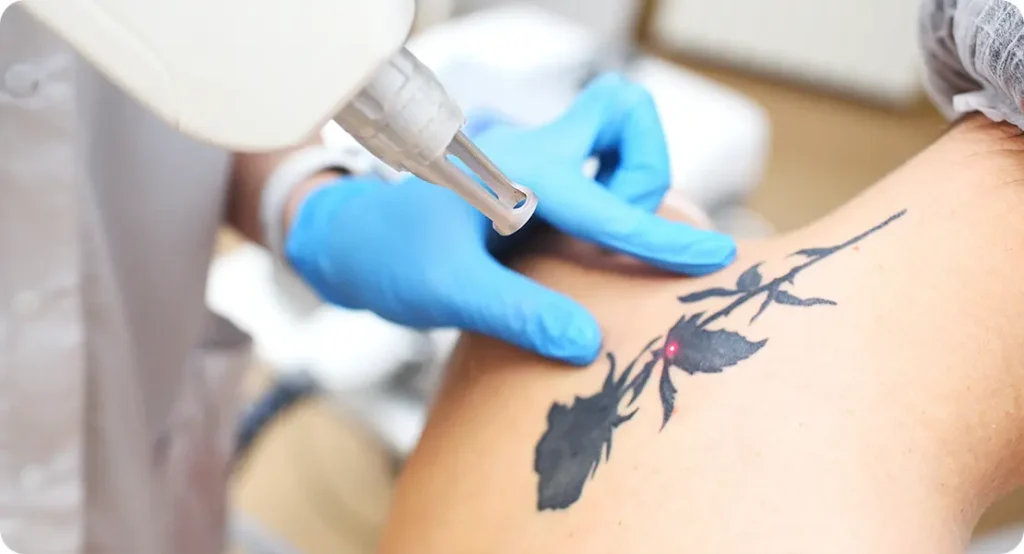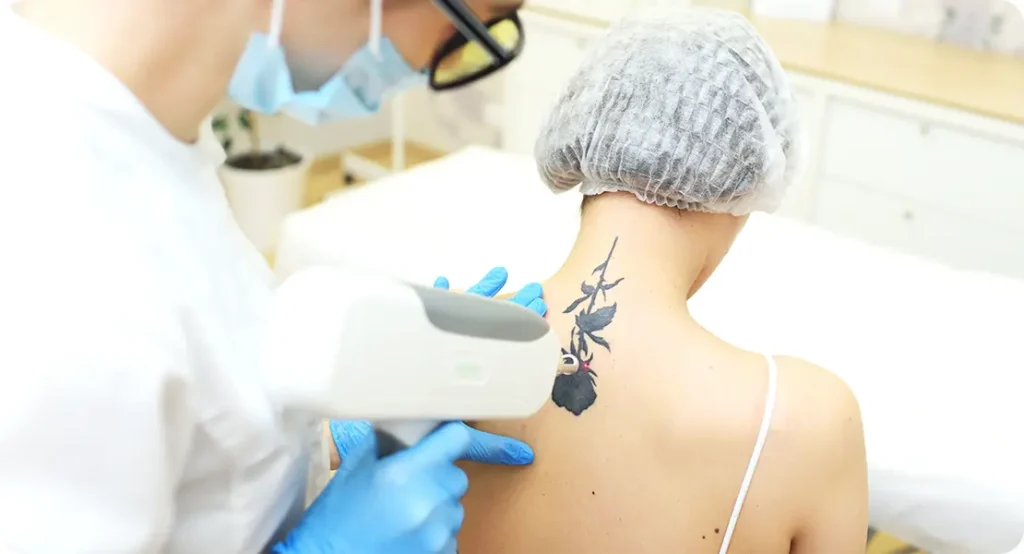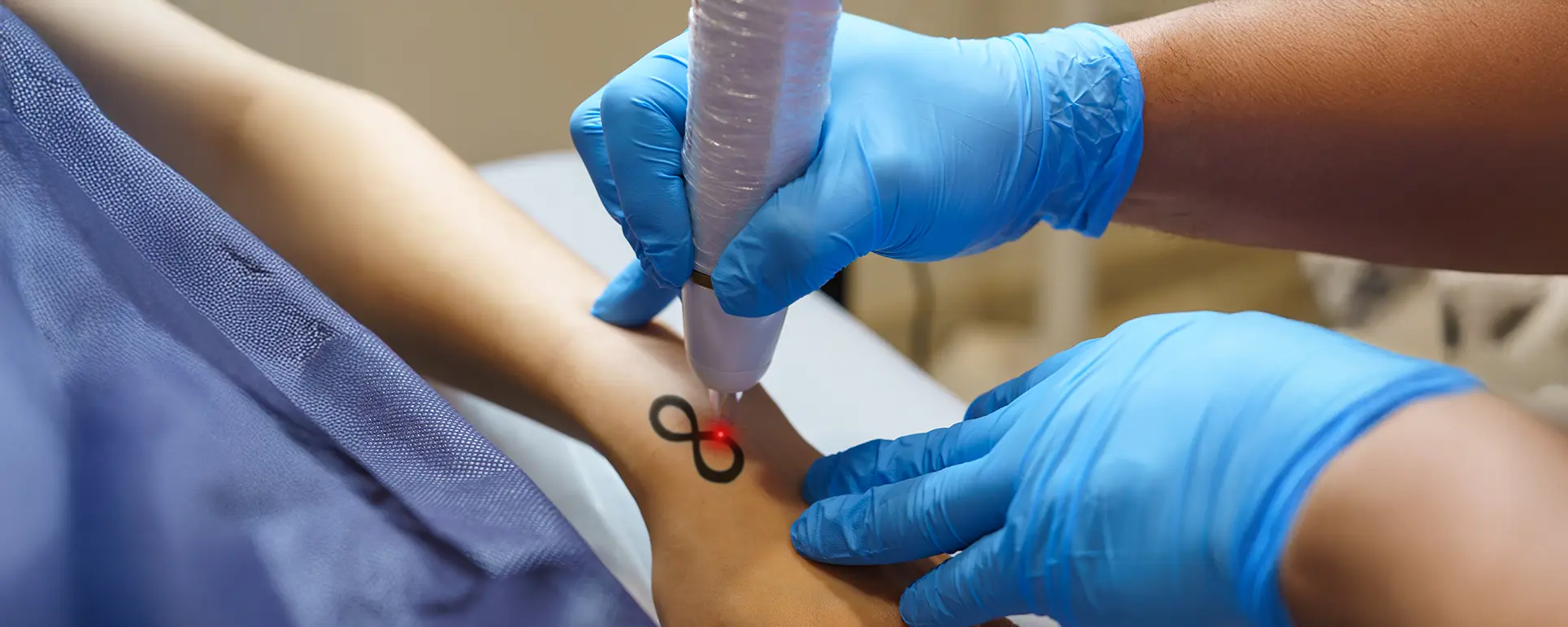Tattoo regret is far more common than most people realise. Whether it’s an ex’s name, a faded symbol from your teenage years, or a design that simply doesn’t reflect who you are anymore, the desire to part ways with old ink is understandable and increasingly achievable. Thanks to significant advances in laser technology, tattoo removal today is faster, more effective, and far less painful than it used to be.
If you’ve explored tattoo removal options in the past, you’ve likely come across Q-switched lasers. For many years, these devices were considered the gold standard in removing unwanted tattoos. They work by delivering powerful bursts of energy to break up the tattoo ink particles beneath your skin, allowing your body’s immune system to flush them away over time. While effective, this method often required multiple sessions spread over many months and complete removal wasn’t always guaranteed.
But times have changed. Now, two cutting-edge technologies picosecond lasers and nanosecond lasers are transforming how we approach tattoo removal. These advanced systems use ultra-fast pulses of energy to shatter ink particles more efficiently and with less damage to the surrounding skin. The result? Fewer sessions, faster healing, and better outcomes even for stubborn colours or older tattoos that previously resisted treatment.
In this article, we’ll break down how picosecond and nanosecond lasers work, the key differences between them, and why they’re quickly becoming the preferred choice for clinics offering tattoo removal in London and beyond. Whether you’re considering your first removal session or looking to restart a process that didn’t work the first time, understanding the technology can help you make a more informed, confident decision.
Why Traditional Tattoo Removal Had Its Limits
Let’s start with the basics.
For many years, Q-switched lasers were the go-to technology for removing unwanted tattoos. These lasers work by delivering high-intensity pulses of light in billionths of a second. The rapid bursts of energy heat the tattoo ink, causing it to shatter into smaller particles that your immune system can gradually clear away.
While this was a major step forward in dermatology and aesthetic medicine, traditional Q-switched laser removal came with several limitations particularly when it came to speed, comfort, and consistency of results.
Here’s what people typically experienced with older Q-switched laser treatments:
- Multiple sessions needed: Most patients required anywhere from 10 to 20 sessions, depending on the tattoo’s size, location, colour, and age. Each session had to be spaced several weeks apart to allow the skin to heal properly.
- A long and drawn-out process: Complete tattoo removal could take several months to even a few years, which often led to frustration, especially when results plateaued halfway through the process.
- Discomfort and downtime: Treatments could be quite painful, sometimes described as worse than getting the tattoo in the first place. Swelling, blistering, and peeling were common during recovery.
- Risk of side effects: There was a higher risk of scarring, burns, and pigmentation changes, especially for people with darker skin tones, who may be more sensitive to laser-induced skin damage.
- Poor performance on certain colours: While black and dark blue inks responded relatively well to Q-switched lasers, brighter colours especially yellow, green, and light blue were notoriously resistant and often faded only partially.
Despite these downsides, Q-switched lasers were considered revolutionary in their time. They offered the first real possibility of tattoo removal without surgery, and for many people, that was a game-changer.
But as demand for tattoo removal grew and as tattoos themselves became more diverse in colour and complexity the limitations of Q-switched technology became increasingly clear.
Thankfully, the science has moved forward. Today, newer and more advanced laser systems like picosecond and nanosecond lasers offer a better, faster, and safer solution. And that’s where things really start to get exciting.
Enter the Picosecond Laser

Picosecond lasers have revolutionised tattoo removal by offering faster, safer, and more effective results than older technologies. As the latest advancement in laser dermatology, they’ve become the go-to option for people seeking quicker tattoo fading with fewer side effects.
The term “picosecond” refers to the duration of the laser pulse just one trillionth of a second. To compare, that’s 1,000 times faster than a nanosecond, the pulse duration used by traditional Q-switched lasers. While this sounds highly technical, it has important practical implications for how efficiently and safely tattoo ink is broken down in the skin.
More Precise Ink Shattering
So, what does this incredible speed really mean for your tattoo removal journey?
When a laser pulse is delivered at picosecond speed, it targets ink particles with intense mechanical pressure rather than heat. This rapid energy creates a photoacoustic effect essentially a shockwave that shatters ink into much smaller particles than older lasers could achieve.
Here’s why that matters:
- Smaller ink particles: These are easier for your body’s lymphatic system to process and eliminate.
- Faster immune clearance: The tiny fragments are removed more quickly, meaning faster overall fading.
- Minimal collateral skin damage: Because less heat is involved, there’s reduced risk of damaging nearby healthy tissue.
As a result, many patients begin to see visible improvements in their tattoo’s appearance after just a few sessions, especially when compared to the 10–20 sessions often needed with Q-switched lasers.
Better Results on Stubborn Colours
One of the biggest limitations of older tattoo removal technology particularly Q-switched lasers was their inability to effectively treat certain ink colours. While black and dark blue tattoos typically responded well, brighter or lighter shades often proved much more difficult to fade. Picosecond lasers have changed that. Thanks to their ultra-fast pulse speed and high peak power, they can break down ink pigments more thoroughly, even in colours that were once considered nearly impossible to fully remove.
These include:
- Green – Traditionally one of the most stubborn colours, now significantly more responsive to treatment.
- Blue – Especially lighter or turquoise tones, which used to fade unevenly with older lasers.
- Yellow – A notoriously resistant shade that picosecond lasers can now target with far greater efficiency.
- Light purple and pastel tones – Once thought to be permanent, these can now be lightened or removed entirely over multiple sessions.
The enhanced precision of picosecond lasers allows them to adapt to a broader spectrum of wavelengths and pigment densities, making them ideal for multicoloured or complex tattoos that were previously left partially faded.
Reduced Risk of Side Effects
Laser tattoo removal has always carried a risk of side effects especially when using older technologies that relied heavily on heat to break up the ink. These included blistering, scarring, and pigmentation issues, particularly for individuals with sensitive or darker skin tones.
Picosecond lasers offer a much safer and gentler alternative. Because they deliver energy so rapidly and rely on mechanical pressure instead of thermal damage, they create significantly less heat within the skin.
Here’s how that translates into real benefits:
- Lower risk of blistering and burns: The cooler approach minimises trauma to the top layers of skin, making treatments more comfortable and reducing the chance of complications.
- Minimal hyperpigmentation or hypopigmentation: Your natural skin tone is less likely to be affected, which is especially important for people with melanin-rich skin.
- Faster healing times: With less inflammation and surface damage, your skin can recover more quickly between sessions helping you complete the full course of treatment in a shorter overall timeframe.
For many people, this means a more predictable, less stressful removal process, with better cosmetic outcomes and greater peace of mind. If fear of scarring or permanent skin changes has held you back from pursuing tattoo removal, picosecond technology offers a far more reassuring path forward.
What About Nanosecond Lasers?

As laser tattoo removal technology continues to evolve, you may come across another option on the spectrum: the nanosecond laser. These devices fall somewhere between the older Q-switched lasers and the newer picosecond lasers in terms of speed, precision, and performance.
Nanosecond lasers operate using laser pulses that last one billionth of a second faster than Q-switched lasers but not quite as rapid as the trillionth-of-a-second pulses delivered by picosecond devices.
So where do they fit in and are they worth considering?
Are They Worth Considering?
In certain situations, yes. While picosecond lasers remain the top-tier choice for comprehensive tattoo removal, nanosecond lasers can offer a practical alternative, especially for specific cases or budget-conscious patients.
Here are some scenarios where nanosecond lasers might be a good fit:
- Lower cost: Because the technology is slightly older and more widely available, nanosecond treatments are typically more affordable than sessions with high-end picosecond machines. This can make tattoo removal more accessible for those on a budget.
- Faster than Q-switched options: Nanosecond lasers still deliver a significant upgrade over traditional Q-switched systems, with shorter pulse durations that help break down ink more efficiently especially in darker, simpler tattoos.
- Good for smaller or lighter tattoos: For tattoos that are not deeply saturated or consist of only one or two colours, nanosecond lasers can provide satisfactory results without requiring the investment of a picosecond device.
That said, it’s important to understand their limitations.
What to Expect from Modern Tattoo Removal in London
If you’re thinking about removing a tattoo today, you’ll be pleased to know that the process has come a long way. Thanks to advancements in laser technology particularly picosecond and nanosecond lasers the experience is faster, safer, and more tailored than ever before. Here’s what a typical tattoo removal journey might look like when you choose a reputable clinic in London using the latest equipment:
1. Personalised Assessment
Your journey begins with a comprehensive consultation, typically conducted by a dermatologist or trained laser specialist. This initial step is crucial for ensuring safe and effective results.
During the assessment, the clinician will examine:
- Your skin type and tone (using the Fitzpatrick scale) to determine how your skin might respond to laser treatment
- The size and location of your tattoo
- The colours used since certain pigments respond better to specific wavelengths
- How old the tattoo is, as older ink tends to fade more easily
- Whether the tattoo is professional or amateur, which affects the depth and density of the ink
2. Fewer Treatment Sessions
Thanks to the superior performance of picosecond lasers, most patients now require significantly fewer sessions than they would have with older Q-switched systems.
- Instead of 10 to 20 sessions, many people can achieve satisfying results in just 4 to 8 sessions
- The interval between treatments is often shorter, around 6 to 8 weeks, compared to the 10–12 weeks required with traditional lasers
This not only speeds up the overall process but also reduces the emotional and financial burden associated with prolonged treatment plans.
3. Less Pain, Faster Recovery
Laser tattoo removal is often described as uncomfortable but with modern devices, it’s far more tolerable than it used to be.
Because picosecond lasers deliver energy faster and with less heat, there’s less trauma to the skin, which means:
- Minimal redness and inflammation following each session
- Fewer scabs, blisters, or crusting during the healing phase
- Shorter downtime, with most people resuming normal activities within 2 to 3 days
As for the actual sensation, many patients compare it to a series of rapid rubber band snaps against the skin unpleasant, but manageable. To reduce discomfort further, clinics often apply topical numbing creams 20–30 minutes before the procedure begins.
4. Better Results for All Skin Tones
One of the most exciting developments in tattoo removal is the increased safety and efficacy for darker skin tones. Older lasers, especially Q-switched devices, posed a higher risk of hyperpigmentation (dark spots) or hypopigmentation (light spots), particularly in Fitzpatrick skin types IV to VI.
Picosecond lasers, by contrast, offer more controlled and precise energy delivery, significantly lowering the risk of pigment-related side effects. This makes modern tattoo removal a much more viable option for people of all ethnic backgrounds and skin tones.
Whether you have fair, olive, brown, or black skin, today’s technologies offer safer and more inclusive solutions than ever before.

How to Maximise Your Results
While advanced lasers can dramatically improve the tattoo removal process, your personal care before and after each session also plays a crucial role in achieving the best outcome. Here are a few simple but effective ways to support your skin and speed up the removal process:
- Avoid sun exposure before and after each session: UV exposure can increase your risk of hyperpigmentation or hypopigmentation. Make sure to keep the treated area covered or protected with a high-SPF sunscreen if you need to be outdoors. Tanned or sunburned skin may also delay your treatment schedule.
- Follow all aftercare instructions carefully: Proper aftercare helps prevent infection, scarring, and irritation. Your clinician will usually recommend keeping the area clean and dry, avoiding scratching or picking, and applying soothing ointments if needed. Adhering to these guidelines is key to a smooth recovery.
- Stay hydrated and support your immune system: Tattoo removal relies on your body’s lymphatic system to flush out the broken-down ink particles. Drinking plenty of water, eating a nutrient-rich diet, getting adequate sleep, and exercising regularly can all contribute to faster ink clearance.
- Be patient with the process: Even though picosecond lasers work faster than traditional methods, complete tattoo removal still requires time. Ink that has been deeply embedded or layered over may take several sessions to fully break down. Trust the process and stay consistent with your appointments.
Frequently Asked Questions
- Can any tattoo be fully removed?
A: Most can but it depends on the ink type, colour, depth, and your skin. Some tattoos fade significantly but may leave a shadow. - Is laser tattoo removal safe?
A: Yes when done by a qualified dermatologist using medical-grade lasers. Avoid unregulated clinics offering cut-rate prices. - Will it hurt?
A: There’s some discomfort, but most people tolerate it well. Numbing options are available. - Can I remove just part of a tattoo?
A: Absolutely. Lasers can be used with precision to fade or erase specific areas.
Final Thought: A New Chapter for Your Skin
If you’ve been living with a tattoo that no longer feels like “you,” it’s never been a better time to explore your removal options. Picosecond and nanosecond laser technologies are revolutionising what’s possible reducing session numbers, improving colour clearance, and lowering risks. You can get in touch with us to book a consultation at our tattoo removal clinic in London to explore your best options with advanced laser technology. We’ll guide you every step of the way.
References:
- Kuperman-Beade, M., Levine, V.J. and Ashinoff, R. (2001) Laser removal of tattoos, Archivesof Dermatology, 137(3), pp. 351–355. Available at: https://www.ncbi.nlm.nih.gov/pmc/articles/PMC2923957/
- Ross, V.E., Naseef, G.S., Lin, G., Kelly, M., Michaud, N., Flotte, T. and Anderson, R.R. (1998) Comparison of responses of tattoos to picosecond and nanosecond Q-switched neodymium: YAG lasers, Archives of Dermatology, 134(2), pp. 167–171.
Available at: https://www.ncbi.nlm.nih.gov/pmc/articles/PMC7423573/ - Nouri, K. (Ed.) (2022) Tattoo Removal: Current Techniques and Future Trends. Clinics in Dermatology, 40(3), pp. 361–369.
Available at: https://www.ncbi.nlm.nih.gov/pmc/articles/PMC9070660/ - Alster, T.S. and Bansal, S. (2018) Laser tattoo removal: An update, Dermatologic Clinics, 36(3), pp. 253–259.
Available at: https://www.ncbi.nlm.nih.gov/pmc/articles/PMC5857434/
Tierney, E.P., Kouba, D.J. and Hanke, C.W. (2021) Advances in laser tattoo removal, Journal of Clinical and Aesthetic Dermatology, 14(12), pp. 30–36.
Available at: https://www.ncbi.nlm.nih.gov/pmc/articles/PMC8709069/
